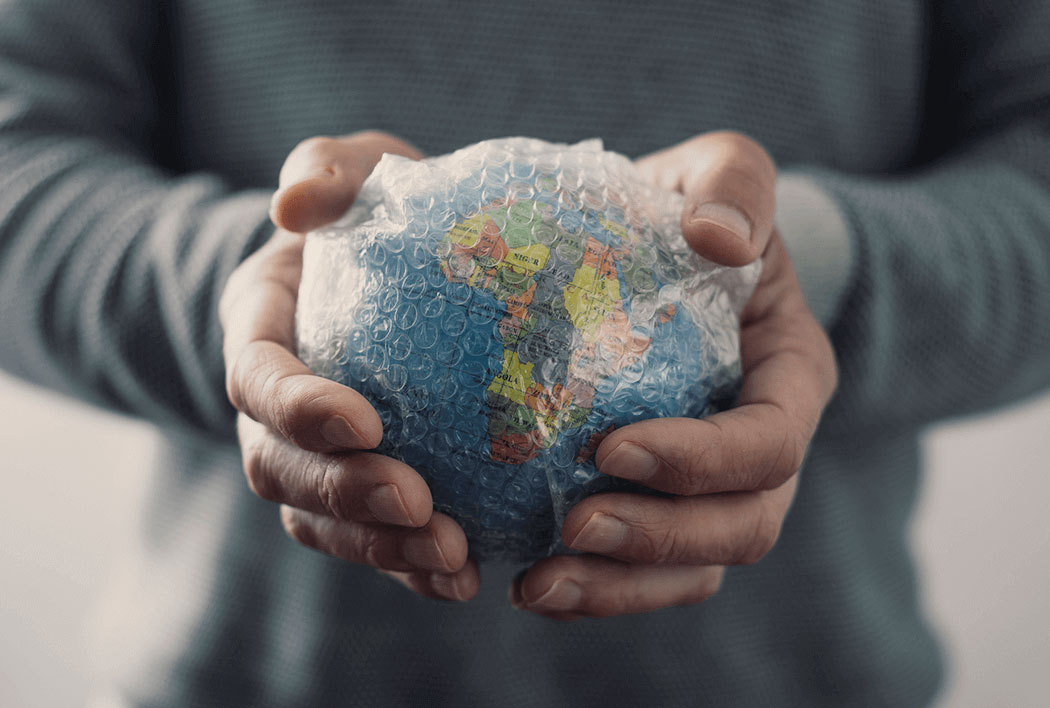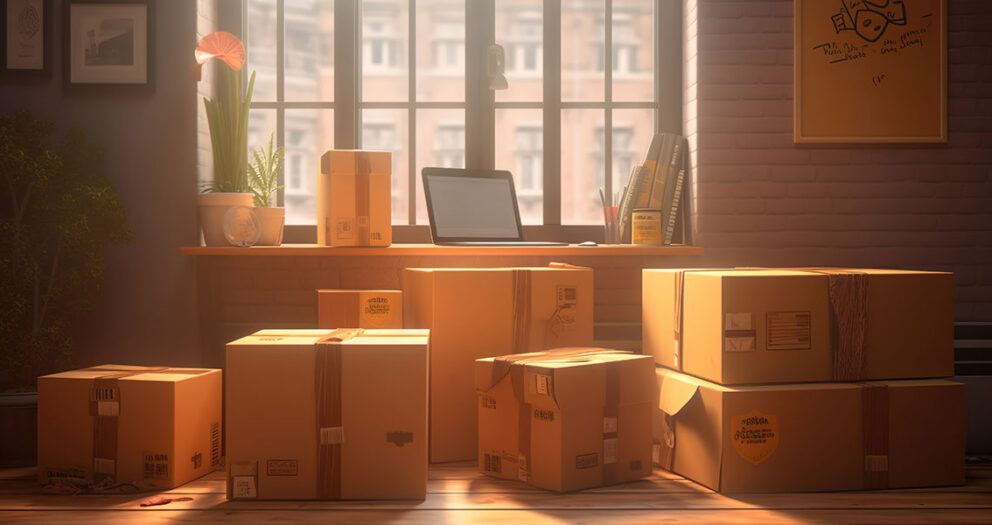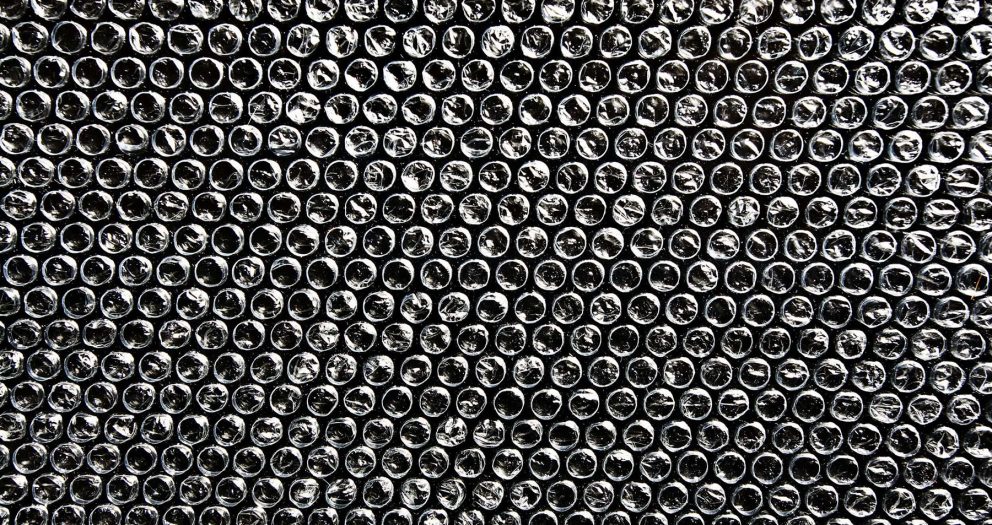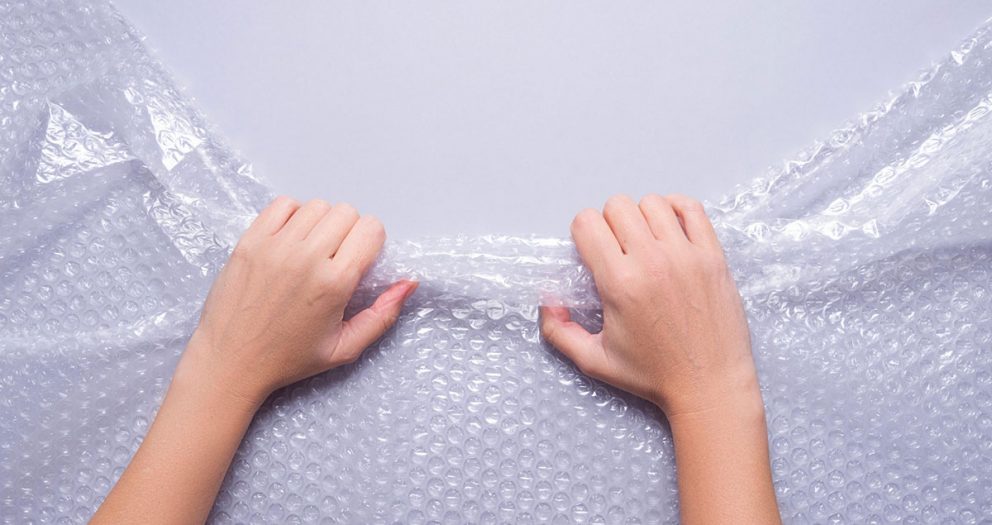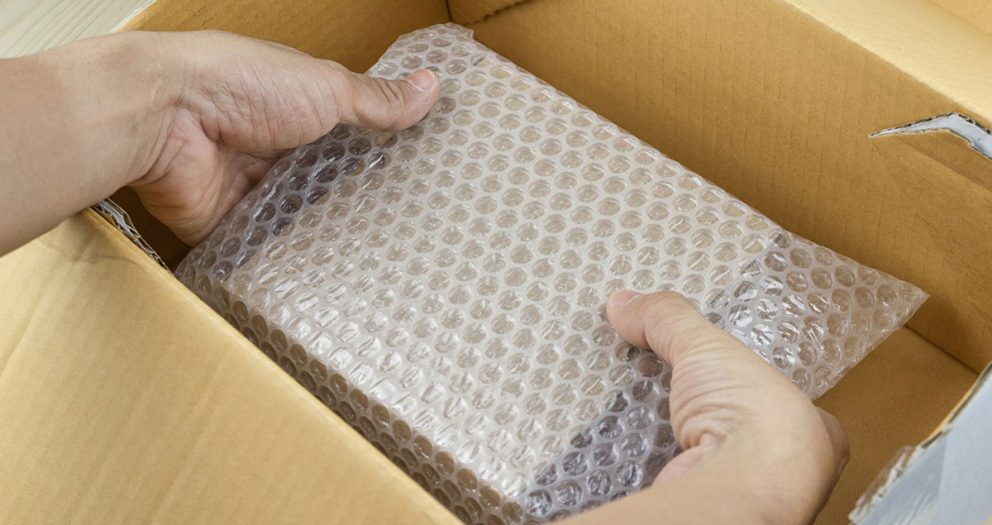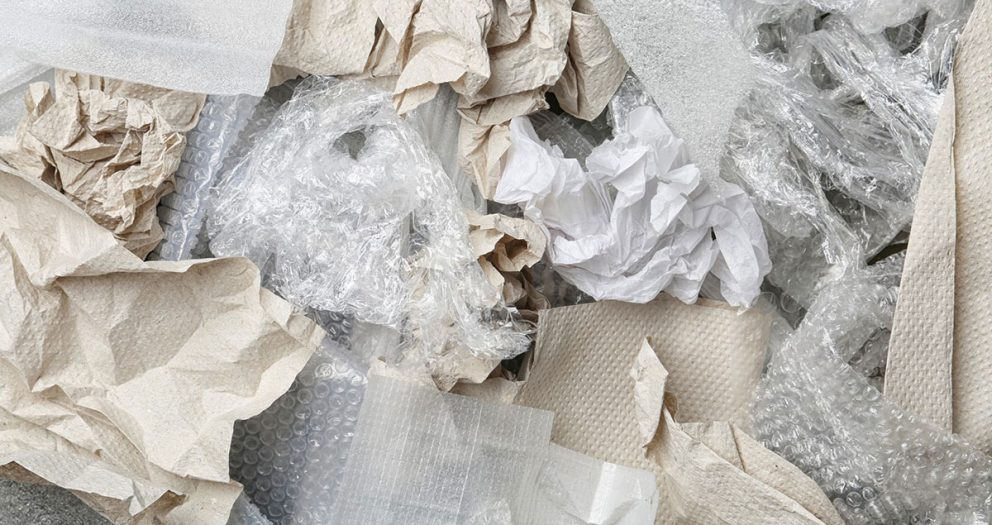Environmentally responsible considerations need to form a part of every business decision, and the choice of packaging is no exception. Bubble wrap, the traditional packaging material of choice, is rarely an eco-friendly choice. Whilst some types of bubble wrap are biodegradable, many are not. Conventional plastic bubble wrap can take centuries to degrade. In the meantime, it takes up valuable space in the landfill. Even attempting to reduce the amount of bubble wrap on the planet by incinerating used wrap is difficult, as the plastic can release toxic gases when burned. For the majority of environmentally aware businesses, it’s time to consider bubble wrap alternatives. Here we take a look at twelve eco-friendly alternative bubble wrap ideas, that could green up your packaging, and may even save you some cash!
1. Paper Wrap
Ideal for packaging fragile items, Hexel Protective Paper Wrap is a bubble wrap substitute that’s made from 100% recycled materials. Not only is the paper wrap made from paper materials that have previously been used, but it’s also 100% recyclable. Protective paper wraps come in a roll that can be cut to size. Once the wrap is cut, its concertina-like construction enables it to be pulled gently to give a honeycomb structure that provides a highly protective covering for any product.
Paper wrap is non-toxic and versatile. Its attractive appearance makes it perfect to showcase new products in an appealing manner, at the same time as ensuring that they arrive at their final destination intact. The Hexcel wrap is sold on a long roll: this makes storage straight-forward and offers a space-saving alternative to bulkier packaging materials. If you’re looking for a bubble wrap alternative that’s incredibly planet-friendly at the same time as offering great performance at an affordable price, paper wrap is a great alternative to consider.
2. Seaweed
Seaweed may not be the most obvious packing material, but it is surprisingly effective. Seaweed for packaging can be grown and harvested with minimal impact on the environment. This means it can be cultivated like any other crop, protecting naturally occurring seaweed from exploitation. Seaweed can be converted into packaging products without the use of damaging chemicals. Once it’s been used, a seaweed packing material is 100% recyclable.
A major advantage of using seaweed to package materials is that it’s non-toxic. There are even some manufacturers who are pioneering the use of seaweed to make edible packaging! Seaweed can be made into drinking straws, food wrap and packaging, among other things. Although seaweed isn’t that well-known as a packaging material, it is a substance that has enormous potential to transform the way food and other products are packaged. If you’re eager to embrace an innovative, yet highly effective, form of packaging, seaweed is worth considering.
3. Old Clothes
Old clothes are another form of packaging that, until recently, has been under-utilised. Layers of old clothing have traditionally been used to protect furniture and crockery during house moves, or to pack fragile items in storage. More modern packaging made from old clothes often involves the clothes being cleaned and shredded (rags) prior to use. Rags are highly adaptable packaging materials: if you’ve got an awkwardly shaped item to ship or pack, rags are ideal to fill in any gaps between the box and the item, reducing the likelihood of movement during transit, as well as protecting the item from damage.
Rags are recycled materials that can be recycled after use, ensuring they tick a large number of green boxes. Unlike some forms of recycled packing material, they don’t require further processing before being reused, helping to keep their carbon footprint as low as possible. The main drawback of old clothes or rags is that they are quite heavy, in comparison to other packing materials. This means they’re unsuitable for items that are being air-freighted, or where large amounts of packaging will be needed that will add significantly to the weight of the item, making it difficult to transport easily.
4. Tissue Paper
If you’re looking for a soft, protective layer that’s also an absolute delight for the eyes, tissue paper is the perfect choice. Unlike cardboard packaging or paper shreds, tissue paper offers a gentler covering that’s ideal for fragile items. Layers of tissue paper can give as much protection as more robust forms of packaging, but its superior appearance means it’s often used as an attractive wrap, before the item is packaged further using packing peanuts, paper wrap or air pillows. Contemporary tissue paper is made from 100% reclaimed paper, and is also 100% recyclable. This makes it a fantastic green alternative to bubble wrap. Advanced production methods mean that tissue paper is now created with minimal use of chemicals, ensuring its construction has only a minimal impact on the environment.
The major advantage of tissue paper is how attractive it can look. If you wish to package your product attractively, at the same time as giving it some much-needed protection, tissue paper is a good option. Available in a selection of colours it can be used for gift wrap, and as a way of presenting a product attractively, as well as for packaging purposes.
5. Scrap Paper
Unlike paper wrap, scrap paper won’t have been pressed into an alternative shape. If you already have sheets of newspaper, or pages from magazines, these can be used to wrap around an item in the same way as bubble wrap or paper wrap. Whilst a sheet of paper does provide some protection from bumps and knocks (as well as offering a degree of thermal protection), it doesn’t offer the same degree of cushioning as paper wrap, biodegradable air pockets or similar. If packing a large volume of goods, there may be issues around consistent packing, particularly when the paper sheets come from several different sources, so are varying sizes or thicknesses. A small point, but if using whole sheets of printed material, it’s also worth checking that the print content isn’t offensive, or unsuitable for your product.
Scrap paper or magazines can also be shredded, then used as packaging. A wide range of shredders are available on the market: whether you pack just a few products a week, or several hundred a day, it’s possible to purchase a shredder that can transform your unwanted paper into useful packing shreds. Note that if considering shredding your own waste paper, there is a cost implication in terms of purchasing and maintaining a shredder, as well as taking into account the labour needed to collect the waste paper, then put it through the shredder. 100% recyclable and an economical option for small volumes of items, using DIY paper shreds for a larger volume of packages can present some challenges.
6. Biodegradable Packaging Peanuts
The green reincarnation of traditional packaging peanuts, these packaging peanuts are designed for void packaging. If you’re trying to protect an awkwardly shaped object during shipping, void packaging is essential. The packaging fills the space between the object and the box, minimising movement and providing a cushion between the item and the outside world. From electrical items through to household goods, homewares and more, these 100% biodegradable packaging peanuts are a great packaging solution. The peanuts flow freely when not under pressure, then interlock to form a protective layer where they’re needed.
The peanuts can be used for multiple packing jobs, and will degrade completely when their useful life has been completed. Few other sustainable packaging materials offer such great void-filling performance as these packaging peanuts.
7. Mushroom Packaging
Mushroom packaging is becoming increasingly popular as a form of sustainable packaging. Mushroom packaging is made from mushroom roots (mycelium). Mushrooms are already grown commercially for food; mushroom packaging is made from the organic mycelium material that would otherwise be discarded. The roots are cleaned, then dehydrated. They can be used as a stand-alone packaging material, or mixed with other sustainable packaging materials (such as rags, or paper), to create a variety of packaging materials. Mushrooms are a sustainable crop, and the production of mushroom packaging involves very few additional resources or energy. The packaging is also 100% biodegradable. For all these reasons, mushroom packaging is a recyclable, sustainable packaging solution that’s growing in popularity.
A benefit of mushroom packaging is that it can be shaped into a variety of designs, using moulds. This makes it a good choice to use for safely packing awkwardly shaped items, provided there is sufficient volume to justify the initial mould-making costs.
8. Sheeps’ Wool
As you would expect from the coat of an animal that’s out in all weathers, sheeps’ wool isn’t just soft and thick, it’s also an excellent thermal insulator. Although it’s not suitable for every form of packaging, it’s gaining popularity as a packing material for products that require a degree of temperature control. One use of sheeps’ wool, when coated in a thin layer of bio-degradable sheeting, is to be used as a packaging layer around cheeses and similar foodstuffs. The sheeps’ wool helps the cheese to stay cool, at the same time as protecting it from knocks and dents during the transport process.
Sheeps’ wool is 100% biodegradable and comes from a sustainable source. Beyond washing, it requires no further processing before it’s used as a packing material. It’s not the cheapest packing material, and can be quite heavy in comparison with paper or card. That said, its insulating properties make it the perfect choice for items that need to be kept cool whilst in transit.
9. Cardboard Boxes
Cardboard boxes offer excellent protection to their contents, which is why they’re still the packing material of choice for millions of homes and businesses. Available in an enormous variety of shapes, sizes and constructions, cardboard boxes can be used to transport anything from white goods through to ornaments, crockery, and much more. Until recently, both homes and businesses used cardboard boxes to transport items. Unfortunately, the rapid rise of plastic packaging has seen the sustainable box losing ground to less environmentally friendly alternatives. The reality is that modern cardboard boxes are 100% recyclable, and are also made from 100% recycled materials.
Not only is there a cardboard box out there that can be used to transport almost anything, cardboard boxes are also a type of packaging that can frequently be reused without the need for further processing. Moving boxes, for example, can be used numerous times before they become too worn to carry anything. Once their useful life is at an end, they can be shredded to form packaging, or recycled in some other way. Cost-effective, environmentally friendly and a secure way to protect a wide range of goods, cardboard boxes are a sustainable packaging staple.
10. Biodegradable Air Pillows
Offering similar benefits to bubble wrap, but without the cost to the environment, air pillows can be used for void packaging, or to wrap around an item to give it protection. Air pillows, as the name suggests, are large pockets of air, contained in biodegradable plastic. Air pillows are made using a biodegradable film and an air pillow machine. This enables the size and shape of the air pillow to be customised to the specific shape of each item that needs packaging. For small batch dispatches, particularly if each item is slightly different, this customised approach to packaging can work really well. For larger volumes of products, air pillows can be quite a labour-intensive option.
Although air pillows are biodegradable, the materials used to make the film aren’t always from recycled materials. In addition, the film manufacturing process uses resources. This means its carbon footprint can be slightly larger than that of alternative forms of green packaging. Air cushion packaging is often used alongside other forms of packaging, such as cardboard boxes or tissue paper.
11. Cornstarch
A relative newcomer on the sustainable packaging scene, cornstarch is a household staple that has a surprising number of advantages. Cornstarch is cheap to produce, and made from maize, which is a sustainable ingredient. Although it is a 100% natural material, cornstarch has several plastic-like properties that mean it makes an amazing packaging material. It can be moulded to fit the shape of almost any item. If you need to transport awkwardly shaped goods, or fragile items, cornstarch will mould itself to the individual contours of the item. This makes it a good choice for void filling. Cornstarch also absorbs water, which can be a benefit when protecting items that need to stay dry during transit.
Many companies use cornstarch because it’s non-toxic (cornstarch is actually a foodstuff). This makes it ideal to pack around food items, or to use on non-food items that may be ingested or be used to produce food. On the downside, cornstarch can be messy to pack with (unless suitably pre-packaged), and can be heavy when a significant volume of it is used. Cornstarch is 100% biodegradable, and its production is a straight-forward process that creates a relatively small carbon footprint. Although not suitable for every packing situation, if you’re looking for an economical, safe and versatile option, cornstarch can work really well.
12. Glass
We know that glass doesn’t automatically spring to mind as a sustainable packaging material, due to its fragile nature. The reality is that glass is used to transport a wide range of beverages and foodstuffs on a daily basis. From the humble milk bottle through to bottles that contain artisan water, wine and much more, glass is the go-to choice for foodstuffs. Glass is actually formed from a natural material (silica). Whilst it doesn’t break down in the same way as an organic material, it’s 100% recyclable. Used glass can simply be reused to make fresh products which, in their turn, can be recycled.
Glass is safe to store food and/or drink in for a considerable period of time. This is important: the past few decades have seen a rise in the number of manufacturers who have begun to use plastic packaging for foodstuffs. Unfortunately, not all plastics are food-safe. Those containing BPA, for example, have been found to potentially carry health risks. Glass is a traditional, sustainable material that has been found safe for use as a packaging material for decades. Provided it’s stored correctly whilst in transit, glass is remarkably robust. It can be tinted, making it ideal for foodstuffs that last longer when kept in darkened conditions. In addition, glass can be shaped into a wide variety of different container sizes and designs. A traditional packing material, glass remains a useful option, particularly for storing substances that need non-reactive, secure and non-toxic packaging.
When considering eco-friendly alternatives to bubble wrap, it’s also important to look at sustainability within the wider business context. As well as using environmentally responsible packaging, businesses can also look at sustainable delivery methods (air freight is generally less environmentally friendly than freight by boat, for example), and the use of sustainable packaging that can be repurposed by consumers as part of the product experience.
Want to find out more about sustainable packaging options? Please get in touch.

